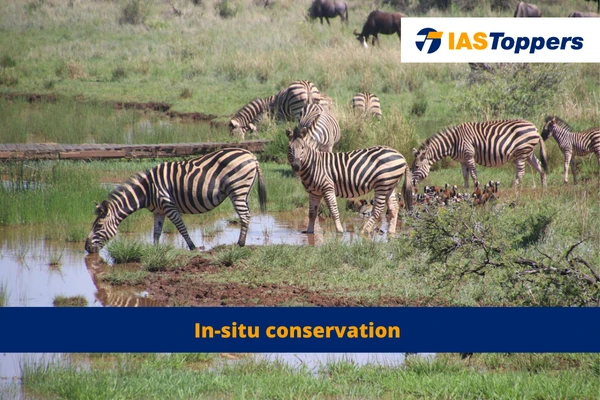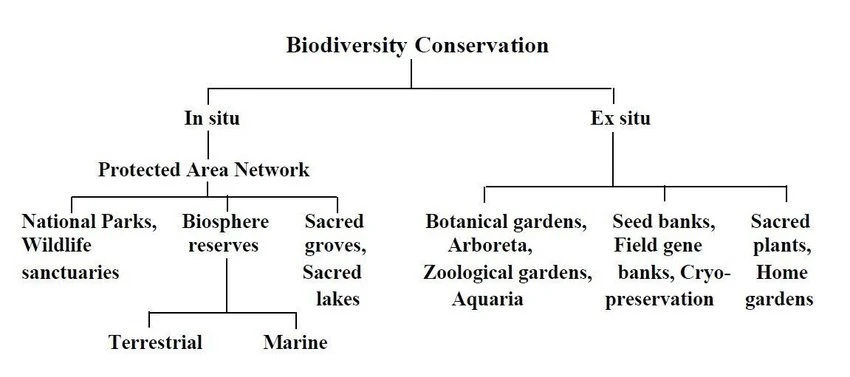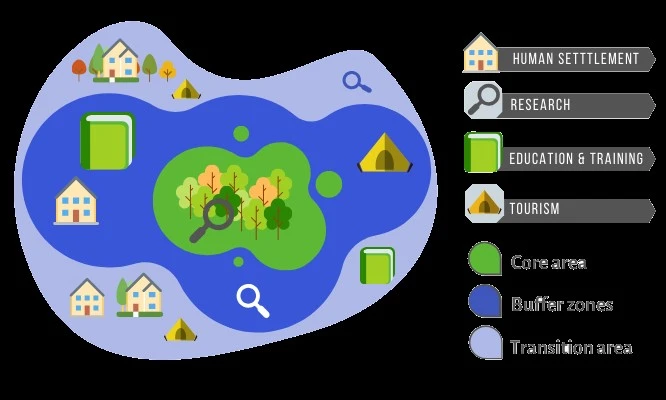In-situ conservation refers to the preservation of wildlife in its natural habitat. In this article, you will learn in situ conservation definition, objectives of in situ conservation, in situ conservation advantages and disadvantages, providing key insights for GS Paper-III Environment and Ecology section of UPSC IAS Exam.
Table of Content
- What is In-situ conservation?
- In-situ conservation diagram
- What is a protected area?
- Objectives of national parks, wildlife sanctuaries and biosphere reserves
- Difference between national parks, wildlife sanctuaries and biosphere reserves
- National parks In-situ conservation
- Wildlife Sanctuaries In-situ conservation
- Biosphere Reserves In-situ conservation
- Wildlife conservation projects
- Advantages of in-situ conservation
- Conclusion
- Frequently Asked Questions
What is In-situ conservation?
- In-situ conservation refers to the preservation of wildlife in its natural habitat.
- The natural habitats under in situ conservation means the actual habitat that the wildlife deems fits for its survival including climatic conditions, food availability and vegetation among others.
- In-situ conservation of wildlife includes maintaining the ecosystems of original habitats or natural environments.
- In-situ conservation of biodiversity involves safeguarding representative landscapes through a system of protected areas on land or in the sea.
- In-situ conservation methods includes creating protected areas, genetic reserve, community reserves, on-farm cultivation, and home garden conservation.
- In-situ conservation examples includes protected areas such as national parks, wildlife sanctuaries and biosphere reserves.
- In-situ conservation measure taken by India includes:
- Declaration of protected areas under the Wildlife Protection Act 1972.
- Gene sanctuary are set up in the Garo Hills of Meghalaya for wild citrus.
- Community reserves protected under the Wildlife Protection Amendment Act 2002 that provide legal support to reserves which cannot be designated as protected areas.
In-situ conservation diagram:
What is a protected area?
- It refers to a defined geographical space managed and conserved for the betterment of nature and wildlife.
- These areas are established and overseen by governments, non-governmental organizations, or other entities to preserve the natural environment, biodiversity, and ecosystems for both present and future generations.
Objectives of national parks, wildlife sanctuaries and biosphere reserves:
- Preserving natural habitats by responsibly managing use of species.
- Ensuring a sustainable population of species in protected areas.
- Establishing and safeguarding designated regions through conservation laws.
- Raising public awareness about wildlife protection.
- Conducting targeted research on wildlife in specific areas.
Difference between national parks, wildlife sanctuaries and biosphere reserves:
National parks In-situ conservation:
- A national park is a designated area that is exclusively reserved for the protection and improvement of wildlife.
- It prohibits human activities such as forestry, grazing, or cultivation in the declared region.
- Even private ownership rights are not allowed.
- These areas are accessible to the public for recreational pursuits, including hiking, camping, and wildlife observation (such as safaris).
- Example:
- Jim Corbett (first National Park of India)
- Sunderbans (West Bengal)
- Dudhva (Uttar Pradesh)
- Tadoba (Maharashtra)
Wildlife Sanctuaries In-situ conservation:
- A wildlife sanctuary is an allocated zone dedicated solely for the conservation of animal and plant species.
- It permits certain human activities such as the collection of minor forest products and allows private ownership rights, while ensuring the preservation of wildlife.
- It is open to the public for educational purposes but recreational activities are restricted.
- Example:
- Periyar (Kerala)
- Ranipur (Uttar Pradesh)
- Chilka Lake (Orissa)
- Sariska (Rajasthan)
Biosphere Reserves In-situ conservation:
- A biosphere reserve is a designated area of land or coastal environment where different land uses are allowed by dividing it into specific zones.
- The core zone represents an undisturbed ecosystem that receives legal protection.
- Buffer zone: surrounding the core zone is the buffer zone, which is managed to accommodate a widerrange of resource use.
- Some research and educational activities are permitted here.
- Transition zone: is located at the outermost part of the biosphere reserve.
- Itfosters active cooperation between management and local communities.
- Activities allowed: cropping, forestry, recreation, fishery cropping, forestry, recreation, fishery etc.
Some wildlife conservation projects:
- Project Tiger: launched in 1973 by the Central Government to preserve the tiger population in India and preventing their extinction.
- Project Lion: habitat development and addressing the issue of diseases in lion.
- Gir Lion Project: Conservation efforts at the Gir forest in Gujarat to protect and conserve the Asiatic lion population in that region.
- Project Crocodile: to conserve Crocodiles by protecting their eggs and rearing them.
- Project elephants: to safeguard elephants and identify elephant reserves for their protection.
Advantages of in-situ conservation:
- Flora and fauna thrive undisturbed in their native habitats, free from human intervention.
- Organisms follow their natural life cycles, allowing for uninterrupted evolutionary progress.
- It ensures the presence of vital green cover and its associated environmental advantages.
- It is a cost-effective and manageable approach.
- The rights and interests of indigenous communities are also safeguarded.
Conclusion
In-situ method of biodiversity conservation plays a vital role in preserving the natural habitats of flora and fauna without human interference. It enables the uninterrupted progression of life cycles and evolutionary processes. This approach provides essential carbon sink and environmental benefits in a cost–effective and manageable manner.
Ref: Source-1
| Other Articles in Environment & Disaster Management | |
| Ex situ conservation | Ramsar convention |
| Wildlife Protection Act 1972 | National Green Tribunal |
| Wildlife trust of India | Compensatory Afforestation |
FAQs (Frequently Asked Questions)
What do you mean by In-situ conservation? State with examples.
In-situ conservation refers to the conservation of species within its own natural habitat.
What is the difference between In-situ and Ex- situ conservation of biodiversity?
In-situ conservation and Ex- situ conservation are meant to conserve wildlife species such as plants and animals. While, In-situ conservation focuses on conservation in own natural habitat, Ex- situ conservation focuses on creating external environment outside of its natural habitat.
What are the examples of In-situ and ex situ conservation?
In–situ conservationexamples are Wildlife sanctuaries, biosphere reserves, national parks whereas exsitu conservation examples are Zoological parks, botanical gardens etc.
What are the advantage and disadvantage of in situ conservation?
In-situ conservation disadvantages are that there are many uncontrolled factors such as climate, environment etc.
Is botanical garden a type of in situ conservation?
No, botanical garden is not In-situ conservation.
What are the types of in situ conservation?
In-situ conservation types
Is biosphere reserve In-situ conservation?
Yes, biosphere reserve is In-situ conservation.






